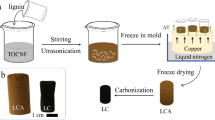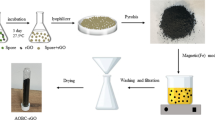Abstract
Cellulose, which is one of the main components of wood biomass, was carbonized and activated by KOH to prepare a hierarchical porous carbon. This biomass derived carbon was successfully utilized as an effective sensor’s material for simultaneously determine hydroquinone (HQ) and catechol (CC) through cyclic voltammetry and amperometry techniques. The resulting sensor exhibited wide linear ranges for HQ (0.5–3000 μmol/L) and CC (1–3000 μmol/L), with the detection limits of HQ (0.47 μmol/L) and CC (0.4 μmol/L) by amperometry technique, respectively. In addition, the prepared sensor also possesses good performances including specific selectivity, long lifetime and good applicability. The practical application in domestic lake water samples with satisfied recoveries implies the proposed sensor is promising. These results demonstrate that cellulose containing biomass have potential as an effective precursor of porous carbon materials and are applicable on various electrochemical sensors.








Similar content being viewed by others
References
Wang J, Park JN, Wei XY, Lee CW (2003) Room-temperature heterogeneous hydroxylation of phenol with hydrogen peroxide over Fe2+, Co2+ ion-exchanged Naβ-zeolite. Chem Commun 5:628–629. https://doi.org/10.1039/B212296K
Timur S, Pazarlioğlu N, Pilloton R, Telefoncu A (2003) Detection of phenolic compounds by thick film sensors based on Pseudomonas putida. Talanta 61:87–93. https://doi.org/10.1016/S0039-9140(03)00237-6
Xie TY, Liu QW, Shi YR, Liu QY (2006) Simultaneous determination of positional isomers of benzenediols by capillary zone electrophoresis with square wave amperometric detection. J Chromatogr A 1109:317–321. https://doi.org/10.1016/j.chroma.2006.01.135
Nagaraja P, Vasantha RA, Sunitha KR (2001) A new sensitive and selective spectrophotometric method for the determination of catechol derivatives and its pharmaceutical preparations. J Pharm Biomed Anal 25:417–424. https://doi.org/10.1016/S0731-7085(00)00504-5
Guo XC, Xia ZY, Wang HH, Kang WY, Lin LM, Cao WQ, Zhang HW, Zhou WH (2017) Molecularly imprinted solid phase extraction method for simultaneous determination of seven nitroimidazoles from honey by HPLC-MS/MS. Talanta 166:101–108. https://doi.org/10.1016/j.talanta.2017.01.047
Pistonesi MF, Nezio MSD, Centurión ME, Palomeque ME, Lista AG, Band BSF (2006) Determination of phenol, resorcinol and hydroquinone in air samples by synchronous fluorescence using partial least-squares (PLS). Talanta 69:1265–1268. https://doi.org/10.1016/j.talanta.2005.12.050
Ghanem MA (2007) Electrocatalytic activity and simultaneous determination of catechol and hydroquinone at mesoporous platinum electrode. Electrochem Commun 9:2501–2506. https://doi.org/10.1016/j.elecom.2007.07.023
Unnikrishnan B, Ru PL, Chen SM (2012) Electrochemically synthesized Pt-MnO2 composite particles for simultaneous determination of catechol and hydroquinone. Sens Actuators B Chem 169:235–242. https://doi.org/10.1016/j.snb.2012.04.075
Newair EF, Khairy M (2023) Sensitive electrochemical quantification of proanthocyanidins in Grapevine (Vitis vinifera) by utilizing disposable screen-printed carbon electrodes. Electroanalysis 35:e202200358. https://doi.org/10.1002/elan.202200358
Wang LT, Zhang Y, Du YL, Lu DB, Zhang YZ, Wang CM (2012) Simultaneous determination of catechol and hydroquinone based on poly (diallyldimethylammonium chloride) functionalized graphene-modified glassy carbon electrode. J Solid State Electrochem 16:1323–1331. https://doi.org/10.1007/s10008-011-1526-1
Jiang H, Zhang DX, He ZF, Lian QW, Xue ZH, Zhou XB, Lu XQ (2015) A novel sensitive electrochemical sensor for the simultaneous determination of hydroquinone and catechol using tryptophan-functionalized graphene. Anal Lett 48:1426–1436. https://doi.org/10.1080/00032719.2014.984188
Yue XY, Pang SP, Han PX, Zhang CJ, Wang JL, Zhang LX (2013) Carbon nanotubes/carbon paper composite electrode for sensitive detection of catechol in the presence of hydroquinone. Electrochem Commun 34:356–359. https://doi.org/10.1016/j.elecom.2013.07.016
Newair EF, Bakr A, El-Sagher HM, Khairy M (2023) Multiwalled carbon nanotube/reduced graphene oxide-decorated β-cyclodextrin polymer microflowers for simultaneous detection of antioxidants. Mater Chem Phys 297:127363. https://doi.org/10.1016/j.matchemphys.2023.127363
Selvi SV, Lincy V, Chen SM, Hong PD, Prasannan A (2021) Highly soluble polythiophene-based strontium-doped NiO nanocomposite for effective electrochemical detection of catechol in contaminated water. J Mol Liq 334:116490. https://doi.org/10.1016/j.molliq.2021.116490
Meskher H, Achi F (2022) Electrochemical sensing systems for the analysis of catechol and hydroquinone in the aquatic environments: a critical review. Crit Rev Anal Chem 1–14. https://doi.org/10.1080/10408347.2022.2114784
Yalikun N, Xu L, Yang XQ, Wang Q (2021) Highly sensitive electrochemical sensor for the detection of hydroquinone and catechol based on biomass derived activated carbon. Sci Adv Mater 13:2178–2184. https://doi.org/10.1166/sam.2021.4129
Hirunpraditkoon S, Srikun S, Nuithitikul K (2015) Removal of lead (II) ions by activated carbon prepared from durian peel: adsorption kinetics and isotherms. Environ Eng Manag J 14:2771–2782. https://doi.org/10.30638/eemj.2015.294
Zhang WJ, Liu L, Li YG, Wang DY, Ma H, Ren HL, Shi YL, Han YJ, Ye BC (2018) Electrochemical sensing platform based on the biomass-derived microporous carbons for simultaneous determination of ascorbic acid, dopamine, and uric acid. Biosens Bioelectron 121:96–103. https://doi.org/10.1016/j.bios.2018.08.043
Nisa ZU, Chuan LK, Guan BH, Ahmad F, Ayub S (2023) A comparative study on the crystalline and surface properties of carbonized mesoporous coconut shell chars. Sustain-Basel 15:6464. https://doi.org/10.3390/su15086464
Chen DJ, Zhou HF, Li H, Chen J, Li SX, Zheng FY (2017) Self-template synthesis of biomass-derived 3D hierarchical N-doped porous carbon for simultaneous determination of dihydroxybenzene isomers. Scientific Rep 7:14985. https://doi.org/10.1038/s41598-017-15129-7
Khalil KMS, Allam OAS, Khairy M, Mohammed KMH, Elkhatib RM, Hamed MA (2017) High surface area nanostructured activated carbons derived from sustainable sorghum stalk. J Mol Liq 247:386–396. https://doi.org/10.1016/j.molliq.2017.09.090
Khalil KMS, Khairy M, Allam OAS, Khalil MK (2022) Formation of improved activated carbons from sugarcane bagasse as environmental materials for adsorption of phenolic pollutants. Environ Sci Technol 19:3103–3116. https://doi.org/10.1007/s13762-021-03382-3
Kim D, Kim JM, Jeon Y, Lee J, Oh J, Antink WH, Kim D, Piao YZ (2018) Novel two-step activation of biomass-derived carbon for highly sensitive electrochemical determination of acetaminophen. Sensors Actuat B-Chem 259:50–58. https://doi.org/10.1016/j.snb.2017.12.066
Sreevani P (2018) International Conference on Renewable Energy Research and Education (RE2-2018). AIP Conf Proc, 010001. https://doi.org/10.1063/1.5047947
Ma SH, He F, Tian D, Zou DT, Yan ZB, Yang YL, Zhou TC, Huang KY, Shen HH, Fang JY (2018) Variations and determinants of carbon content in plants: a global synthesis. Biogeosciences 15:693–702. https://doi.org/10.5194/bg-2017-322
Tian Y, Ma YL, Liu HP, Zhang X, Peng W (2015) One-step and rapid synthesis of nitrogen and sulfur co-doped graphene for hydrogen peroxide and glucose sensing. J Electroanal Chem 742:8–14. https://doi.org/10.1016/j.jelechem.2015.01.029
Chen LF, Huang ZH, Liang HW, Gao HL, Yu SH (2014) Three-dimensional heteroatom-doped carbon nanofiber networks derived from bacterial cellulose for supercapacitors. Adv Funct Mater 24:5104–5111. https://doi.org/10.1002/adfm.201400590
Huang Y, Zheng MB, Lin ZX, Zhao B, Zhang ST, Yang JZ, Zhu CL, Zhang H, Sun DP, Shi Y (2015) Flexible cathodes and multifunctional interlayers based on carbonized bacterial cellulose for high-performance lithium-sulfur batteries. J Mater Chem A 3:10910–10918. https://doi.org/10.1039/c5ta01515d
Ge C, Li HJ, Li MJ, Li CP, Wu XG, Yang BH (2015) Synthesis of a ZnO nanorod/CVD graphene composite for simultaneous sensing of dihydroxybenzene isomers. Carbon 95:1–9. https://doi.org/10.1016/j.carbon.2015.08.006
Li KX, Chen W, Yang HP, Chen YQ, Xia SW, Xia MW, Tu X, Chen HP (2019) Mechanism of biomass activation and ammonia modification for nitrogen doped porous carbon materials. Bioresour Technol 280:260–268. https://doi.org/10.1016/j.biortech.2019.02.039
Luo W, Wang B, Heron CG, Allen MJ, Morre J, Maier CS, Stickle WF, Ji XL (2014) Pyrolysis of cellulose under ammonia leads to nitrogen-doped nanoporous carbon generated through methane formation. Nano Lett 14:2225–2229. https://doi.org/10.1021/nl500859p
Wang J, Chen ZM, Chen BL (2014) Adsorption of polycyclic aromatic hydrocarbons by graphene and graphene oxide nanosheets. Environ Sci Technol 48:4817–4825. https://doi.org/10.1021/es405227u
Fan ZC, Li Z, Wei XY, Kong QQ, Liu ZQ, Li L, Li JH, Yin F, Lu KL, Zong ZM (2022) Longquan lignite-derived hierarchical porous carbon electrochemical sensor for simultaneous detection of hazardous catechol and hydroquinone in environmental water samples. Microchem J 182:107880. https://doi.org/10.1016/j.microc.2022.107880
Li XX, Li HY, Liu TT, Hei YS, Hassan M, Zhang SY, Lin JX, Wang TS, Bo XJ, Wang HL, Li HD, Zhou M (2018) The biomass of ground cherry husks derived carbon nanoplates for electrochemical sensing. Sensor Actuat B-Chem 255:3248–3256. https://doi.org/10.1016/j.snb.2017.09.151
Yu HJ, Shi R, Zhao YX, Bian T, Zhao YF, Zhou C, Waterhouse GIN, Wu LZ, Tung CH, Zhang TR (2017) Alkali-assisted synthesis of nitrogen deficient graphitic carbon nitride with tunable band structures for efficient visible-light-driven hydrogen evolution. Adv Mater 29:1605148. https://doi.org/10.1002/adma.201605148
Zhu LW, Wu J, Zhang Q, Li XK, Li YM, Cao XB (2018) Chemical-free fabrication of N, P dual-doped honeycomb-like carbon as an efficient electrocatalyst for oxygen reduction. J Colloid Interf Sci 510:32–38. https://doi.org/10.1016/j.jcis.2017.08.078
Zhu GZ, Deng XL, Hou M, Sun K, Zhang YP, Li P, Liang FM (2016) Comparative study on characterization and adsorption properties of activated carbons by phosphoric acid activation from corncob and its acid and alkaline hydrolysis residues. Fuel Process Technol 144:255–261. https://doi.org/10.1016/j.fuproc.2016.01.007
Chen W, Gong M, Li KX, Xia MW, Chen ZQ, Xiao HY, Fang Y, Chen YQ, Yang HP, Chen HP (2020) Insight into KOH activation mechanism during biomass pyrolysis: Chemical reactions between O-containing groups and KOH. Appl Energ 278:115730. https://doi.org/10.1016/j.apenergy.2020.115730
Liu ZH, Liao D, Yu JG, Jiang XY (2022) An electrochemical sensor based on oxygen-vacancy cobalt–aluminum layered double hydroxides and hydroxylated multiwalled carbon nanotubes for catechol and hydroquinone detection. Microchem J 175:107216. https://doi.org/10.1016/j.microc.2022.107216
Zheng XY, Fan RR, Hu YC, Zhong HN, Yang XY, Lv RX, Yang X, Huang B (2020) Selective and simultaneous determination of hydroquinone and catechol by using a nitrogen-doped bagasse activated carbon modified electrode. Mater Chem Phys 242:122525. https://doi.org/10.1016/j.matchemphys.2019.122525
Yin DD, Liu J, Bo XJ, Guo LP (2020) Cobalt-iron selenides embedded in porous carbon nanofibers for simultaneous electrochemical detection of trace of hydroquinone, catechol and resorcinol. Anal Chim Acta 1093:35–42. https://doi.org/10.1016/j.aca.2019.09.057
Liu GY, Liu J, Pan P, Wang ZY, Yang ZC, Wei J, Li P, Cao SX, Shen HD, Zhou J, Zhang XD (2023) Electrochemical sensor based on laser-induced preparation of MnOx/rGO composites for simultaneous recognition of hydroquinone and catechol. Microchem J 185:108234. https://doi.org/10.1016/j.microc.2022.108234
Qi SP, Zhao B, Tang HQ, Jiang XQ (2015) Determination of ascorbic acid, dopamine, and uric acid by a novel electrochemical sensor based on pristine graphene. Electrochim Acta 161:395–402. https://doi.org/10.1016/j.electacta.2015.02.116
Yang X, He CL, Lin WX, Qiu YJ, Li PF, Chen YD, Huang B, Zheng XY (2022) Electrochemical sensors for hydroquinone and catechol based on nano-flake graphite and activated carbon sensitive materials. Synthetic Met 287:117079. https://doi.org/10.1016/j.synthmet.2022.117079
Ganesan S, Sivam S, Elancheziyan M, Senthilkumar S, Ramakrishan SG, Soundappan T, Ponnusamy VK (2022) Novel delipidated chicken feather waste-derived carbon-based molybdenum oxide nanocomposite as efficient electrocatalyst for rapid detection of hydroquinone and catechol in environmental waters. Environ Pollut 293:118556. https://doi.org/10.1016/j.envpol.2021.118556
Lu ZY, Wang Y, Zhu YM, Hasebe Y, Zhang ZQ (2022) Popcorn-derived porous carbon-based electrochemical sensor for simultaneous determination of hydroquinone, Catechol and Nitrite. Chem Sel 7:e202200148. https://doi.org/10.1002/slct.202200148
Mao H, Liu MH, Cao ZQ, Ji CG, Sun Y, Liu DL, Wu SY, Zhang Y, Song XM (2017) Poly (4-vinylphenylboronic acid) functionalized polypyrrole/graphene oxide nanosheets for simultaneous electrochemical determination of catechol and hydroquinone. Appl Surf Sci 420:594–605. https://doi.org/10.1016/j.apsusc.2017.05.188
Zhao L, Yu J, Yue SZ, Zhang LX, Wang ZH, Guo PR, Liu QY (2018) Nickel oxide/carbon nanotube nanocomposites prepared by atomic layer deposition for electrochemical sensing of hydroquinone and catechol. J Electroanal Chem 808:245–251. https://doi.org/10.1016/j.jelechem.2017.12.019
Liu Y, Zhang ZJ, Li YS, Shi F, Ai YJ, Wang BL, Zhang SY, Zhang XP, Sun W (2023) Electrochemical detection of hydroquinone based on marine biomass carbon from shrimp shells as electrode modifier. Int J Electrochem Sc 18:100063. https://doi.org/10.1016/j.ijoes.2023.100063
Chen Y, Liu XY, Zhang S, Yang LQ, Liu ML, Zhang YY, Yao SZ (2017) Ultrasensitive and simultaneous detection of hydroquinone, catechol and resorcinol based on the electrochemical co-reduction prepared Au-Pd nanoflower/reduced graphene oxide nanocomposite. Electrochim Acta 231:677–685. https://doi.org/10.1016/j.electacta.2017.02.060
Funding
This study was financially supported by the Innovation Team Fund of University of Science and Technology Liaoning (2019TD01).
Author information
Authors and Affiliations
Contributions
Jifan Zhao: Writing – original draft. Zhenyong Lu: Experiments; Yue Wang: Conceptualization, Methodology. Baptista José Laurindo Mário: Investigation. Shaoyan Wang: Supervision.
Corresponding authors
Ethics declarations
Competing interests
The authors declare no competing interests.
Additional information
Publisher's Note
Springer Nature remains neutral with regard to jurisdictional claims in published maps and institutional affiliations.
Supplementary Information
Below is the link to the electronic supplementary material.
Rights and permissions
Springer Nature or its licensor (e.g. a society or other partner) holds exclusive rights to this article under a publishing agreement with the author(s) or other rightsholder(s); author self-archiving of the accepted manuscript version of this article is solely governed by the terms of such publishing agreement and applicable law.
About this article
Cite this article
Zhao, J., Lu, Z., Wang, Y. et al. Cellulose-derived hierarchical porous carbon based electrochemical sensor for simultaneous detection of catechol and hydroquinone. Ionics 30, 1089–1100 (2024). https://doi.org/10.1007/s11581-023-05317-z
Received:
Revised:
Accepted:
Published:
Issue Date:
DOI: https://doi.org/10.1007/s11581-023-05317-z




